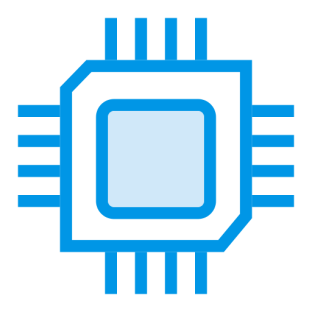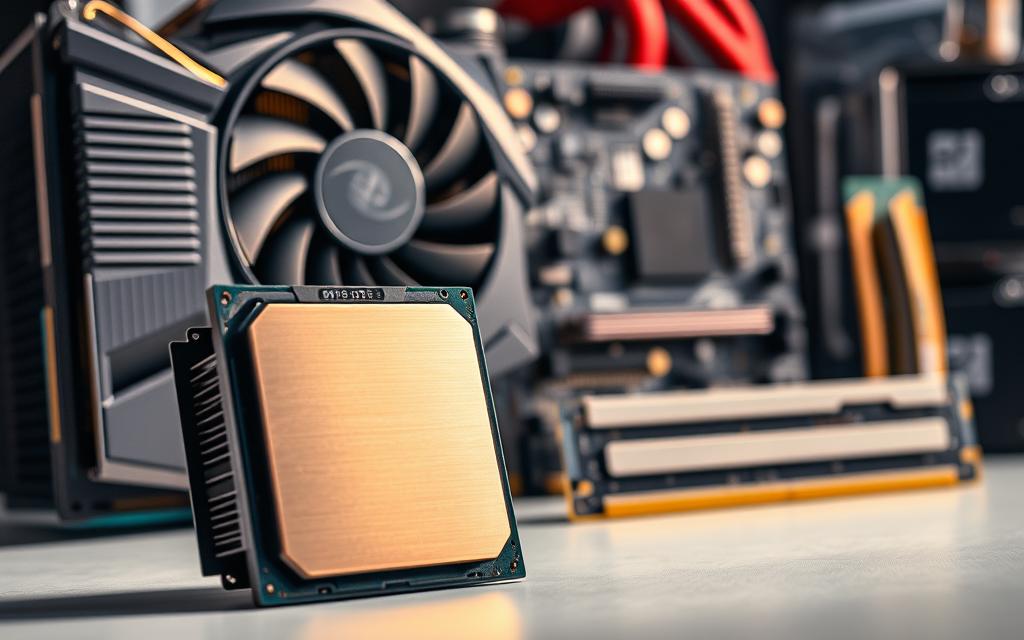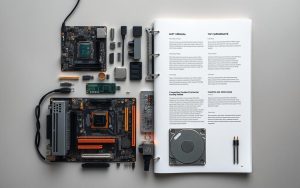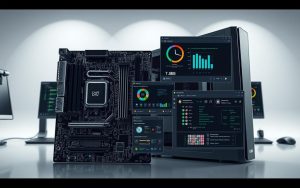Computer hardware forms the physical basis of every digital device. It’s the crucial infrastructure that enables computational processes. These tangible components transform electrical signals into meaningful digital interactions.
Computer hardware is a complex network of physical parts working together. The central processing unit (CPU) acts as the computer’s brain. It performs calculations and manages data flow with precision.
Modern computing depends on hardware components to function. Without physical hardware, a computer can’t execute software instructions or process data. Each hardware element plays a unique role in creating a smooth tech experience.
Virtualization technology has changed how we view hardware functionality. It allows multiple virtual machines to simulate hardware on one physical system. This innovation enables more efficient resource use in computing.
Knowing about computer hardware is key for tech enthusiasts. Hardware drives digital innovation in devices from personal computers to data centers. It remains the fundamental building block of computational capabilities.
What Is Computer Hardware and Its Essential Components
Computer hardware is the physical foundation of any computing system. Essential hardware components work together to enable digital processing, storage, and interaction. These critical parts help users understand how computers function at their core.
Computers rely on various hardware pieces that serve specific functions. The core essential hardware components include:
- Central Processing Unit (CPU)
- Random Access Memory (RAM)
- Storage devices
- Motherboard
- Power Supply Unit (PSU)
Primary Hardware Components
The CPU acts as the computer’s brain, processing instructions and performing calculations. Random Access Memory (RAM) provides temporary storage for active programs and data.
RAM enables quick access and rapid processing. Storage devices like hard disk drives (HDD) and solid-state drives (SSD) permanently save information.
Secondary Hardware Components
Secondary components enhance computer capabilities. Graphics cards manage visual rendering, while sound cards process audio output.
These specialized components improve overall system performance and user experience.
| Component | Primary Function | Performance Impact |
|---|---|---|
| CPU | Process instructions | High computational speed |
| RAM | Temporary data storage | Quick data access |
| Graphics Card | Visual rendering | Enhanced display quality |
Input/Output Devices
Input/output devices enable interaction between users and computers. Keyboards, mice, monitors, and printers allow data input, interaction, and output.
These peripheral devices complete the hardware ecosystem. They transform computational potential into practical usability.
“Hardware is the soul of computing, translating digital instructions into tangible experiences.” – Tech Innovator
The Role of Hardware in Computer Operations
Computer hardware is vital for all digital interactions. It drives data processing and computer operations. These physical parts turn abstract instructions into real computational results.
Hardware functions are key to efficient information processing. The main components work together with technological precision:
- Central Processing Unit (CPU) handles computational tasks
- Random Access Memory (RAM) manages temporary data storage
- Hard drives and SSDs provide long-term data retention
- Motherboard connects and coordinates all hardware components
Data processing relies on complex hardware interactions. Each part adds unique abilities to change raw data into useful information. The CPU acts as the brain, executing millions of calculations per second.
Memory modules ensure quick data retrieval and temporary storage. Computer operations need smooth hardware communication. Modern computing requires advanced hardware functions for complex tasks.
From gaming to scientific research, hardware provides essential support. It enables sophisticated digital experiences in various fields.
Hardware is not just a collection of components, but a sophisticated ecosystem designed to transform digital potential into tangible reality.
Can a Computer Run Without Hardware: Exploring the Possibility
Modern tech like virtualization and cloud computing have changed how we see computer infrastructure. These advancements challenge the idea that computers need physical hardware. New methods are reshaping our understanding of computing systems.
Understanding Virtualization
Virtualization allows multiple virtual machines (VMs) to run on one physical machine. This tech helps companies use resources better and rely less on hardware.
VMs can run at the same time and work independently. Different operating systems can also exist on one physical server.
- Multiple virtual machines can run simultaneously
- Each virtual machine operates independently
- Different operating systems can coexist on one physical server
Cloud Computing and Hardware Constraints
Cloud computing has changed how we think about hardware needs. Virtualization technology lets service providers create flexible computing environments that seem hardware-free.
Cloud computing offers many benefits. These include lower hardware costs, better resource use, and improved scalability.
- Reduced hardware procurement costs
- Enhanced resource allocation
- Improved scalability
Limitations of Hardware-Free Computing
Physical hardware is still crucial, despite big advances in virtualization and cloud computing. Virtual machines need real hardware to work. Their performance depends on the host machine’s specs.
While virtual computing offers unprecedented flexibility, it cannot completely eliminate hardware dependencies.
Computing keeps evolving, hinting at future breakthroughs in hardware-less computing. These advances could change tech landscapes across many fields.
Understanding Operating Systems and Hardware Requirements
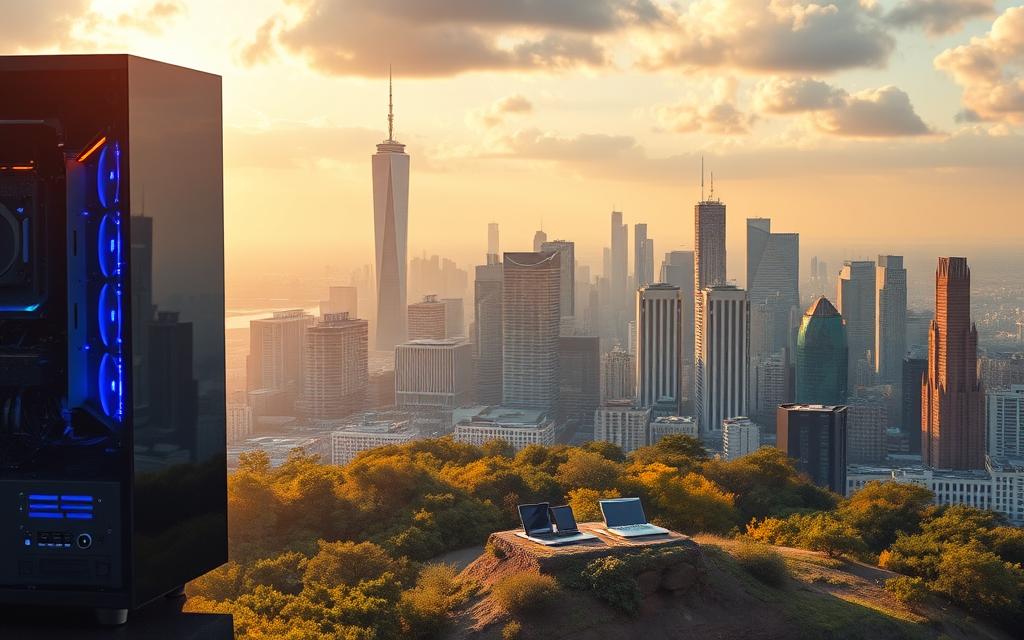
Operating systems bridge computer hardware and software, managing resources and enabling smooth interactions. These platforms are vital to a computer’s functionality. They determine how hardware components communicate and perform tasks.
Different operating systems need specific hardware setups for best performance. Modern systems like Windows 11 or macOS require more advanced hardware than older versions.
- CPU processing power and architecture
- Memory (RAM) capacity
- Storage device types and capacities
- Graphics card capabilities
- Network interface compatibility
System compatibility involves interactions between hardware and operating system software. Manufacturers design hardware with specific operating system requirements in mind. This ensures components can effectively communicate and process instructions.
Key hardware requirements include:
- Minimum processor speed
- Required memory allocation
- Graphics card specifications
- Storage space recommendations
- Network and connectivity options
Understanding these relationships helps users make smart choices about hardware upgrades. It also aids in selecting the right operating system. This knowledge ensures optimal computer performance and functionality.
The Relationship Between Hardware and Software
Computer systems blend hardware and software in perfect harmony. This dynamic duo powers our computing experience. Their interaction drives technological innovation forward.
Let’s explore key aspects of computer functionality. We’ll focus on how hardware and software work together.
How Software Communicates with Hardware
Software needs hardware to execute commands and process information. This communication involves multiple layers of interaction.
- Translation of software instructions into hardware actions
- Utilizing system resources for computation
- Managing data transfer between components
System Resources and Performance
System performance relies on efficient resource allocation. Several key factors influence this process.
| Hardware Component | Performance Impact |
|---|---|
| CPU | Processing speed and multitasking capabilities |
| RAM | Memory capacity and data access speed |
| Storage Drive | Data read/write performance |
Hardware Drivers and Software Compatibility
Hardware drivers act as translators between software and physical components. They ensure software compatibility by enabling smooth communication.
Windows operating systems dominate over 80% of global markets. This fact highlights the importance of strong hardware-software integration across platforms.
Modern Computing Technologies and Hardware Evolution
Computing technologies are changing fast. Hardware improvements are reshaping how we use digital systems. Quantum computing and neuromorphic engineering are pushing the limits of what’s possible.
Here are some key hardware developments:
- Ultra-fast quantum processors
- Advanced neuromorphic computing chips
- High-performance graphical processing units
- Miniaturized storage technologies
“Innovation in hardware is the backbone of technological progress.” – Tech Industry Expert
Modern computing tech is changing quickly. Companies are using new hardware to boost efficiency. The global hardware market is growing fast.
Experts predict big investments in next-gen computing infrastructure. This shows the market’s potential for growth.
| Technology | Market Growth | Key Impact |
|---|---|---|
| Quantum Computing | 25% annual growth | Complex problem solving |
| Neuromorphic Hardware | 18% annual growth | AI neural network simulation |
| Advanced GPUs | 22% annual growth | Enhanced graphics rendering |
These tech changes show ongoing innovation in computing. They promise more powerful and smart systems for the future. These advances will shape how we use computers in coming years.
Virtual Machines and Cloud Infrastructure
Cloud computing has changed how organizations use computing resources. Virtual machines and cloud infrastructure are cutting-edge technologies that break traditional hardware limits.
Virtual machines (VMs) offer powerful solutions for modern computing challenges. They allow multiple operating systems and apps to run on one physical machine. This creates flexible and efficient computing environments.
Benefits of Virtual Computing
Virtualization offers great advantages for businesses and individual users:
- Significant cost savings by reducing physical hardware expenses
- Enhanced resource utilization and scalability
- Improved security through application and system isolation
- Simplified disaster recovery processes
Infrastructure as a Service (IaaS)
Cloud infrastructure through IaaS lets organizations use virtual computing resources without big hardware investments. Providers like Amazon Web Services and Microsoft Azure offer scalable computing environments.
| IaaS Provider | Key Features | Market Share |
|---|---|---|
| Amazon Web Services | Global infrastructure, extensive service range | 32% |
| Microsoft Azure | Strong enterprise integration | 21% |
| Google Cloud Platform | Advanced machine learning capabilities | 9% |
Future of Virtual Computing
The future of virtual computing looks bright. Cloud computing markets may grow 16.3% yearly from 2021 to 2028.
Virtualization technologies will continue transforming how businesses manage computing resources.
“Virtual machines represent the future of flexible, efficient computing infrastructure.” – Cloud Computing Expert
Virtual machines offer amazing capabilities but still need physical hardware. The technology makes better use of resources, creating more efficient and adaptable computing environments.
Conclusion
Computer hardware is vital for tech progress. Physical parts are crucial for computer function, despite cloud computing’s rise. Hardware evolution shows how tech innovations change our view of computing infrastructure.
VMware ESXi and Microsoft Hyper-V have changed resource use. They let multiple virtual machines run at once. This optimizes resources and reduces hardware needs. Still, physical computing resources remain essential for virtual systems.
AI, edge computing, and IoT will push hardware limits. Physical parts will stay key to computing processes. Understanding hardware-software links is crucial for tech pros and fans.
Future computing promises exciting changes. Innovations will connect physical and virtual environments. Hardware will keep evolving, driving tech progress. This will reshape our digital experiences in new ways.
